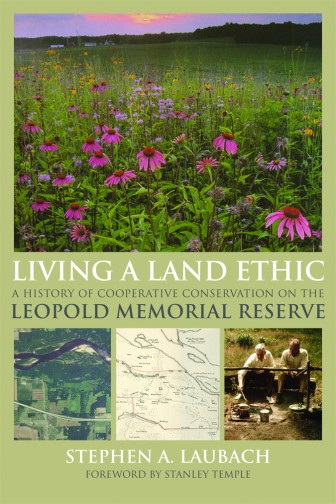
Stephen A. Laubach, author of Living a Land Ethic. Image: UW Press
Stephen A. Laubach works for the Earth Partnership Program at the University of Wisconsin–Madison Arboretum. His 2014 book, Living a Land Ethic, chronicles the development of the 1,600-acre Leopold Memorial Reserve, a conservation project built from a small parcel of land where famed ecologist Aldo Leopold drew inspiration for his A Sand County Almanac.
Great Lakes Echo: What motivated you to write a book chronicling the Aldo Leopold Reserve?
Stephen Laubach: When I came back to Wisconsin to pursue a Ph.D. in Environmental Studies and Science Education, I began to see the need for historical documentation as many of the reserve elders were in their 80s and 90s. Having maintained a relationship with Nina Leopold Bradley, daughter to Aldo Leopold, and the Leopold Foundation itself, I couldn’t resist the opportunity to write the book.
Great Lakes Echo: Did your relationship with Nina Leopold Bradley guide your writing?
Stephen Laubach: Yes. I came to know Leopold’s daughter in the spring of ’99 when I did research on the reserve, helping students with invasive species removal and trail maintenance. Nina would have us on her porch for lunches, saying things like “make your vocation your avocation, make it something you wake up looking forward to do every morning.” Of course, her personal story is about her father.
Great Lakes Echo: How was Aldo Leopold’s work sustained? Did his daughter play a part?
Stephen Laubach: Nina quoted her father frequently — “to care for something we have to develop a relationship with the land if we want to protect and conserve it; we protect what we love.” Nina and her husband Charlie picked up Leopold’s phenology studies at the Reserve and carried them into retirement. Her records followed Leopold’s and enabled her to publish an article assessing the seasonal effects of climate change in Wisconsin.
Great Lakes Echo: What is a land ethic?
Stephen Laubach: Leopold wrote that nothing is as important as an ethic that is written and evolves in the mind of a community. He calls for a community and he calls for an ethic that extends the boundaries of communities to soils, waters, plants and animals beyond the traditional ethical relationships — human to human. The Reserve is one example of an evolving ethic in the minds of a thinking community.
Great Lakes Echo: When did the Reserve realize the threat to its community?
Stephen Laubach: A conservation challenge was identified in the late 60s where the interstates had recently come into play and the land was being parceled and sold just a mile down the road. Reed Coleman, who started The Sand County Foundation, and Leopold looked forward — it wasn’t hard to imagine a time where Leopold’s shack would be surrounded by developments.
Great Lakes Echo: How did landowners address the concern in light of Leopold’s ethics?
Stephen Laubach: It wasn’t just about walling humans out. That’s not what Leopold was about. Coleman and Leopold wanted to both preserve the landscape and the legacy of restoring land to health. It was about formalizing Leopold’s studies in ecological restoration. So, a group of landowners came up with a creative strategy in an era before conservation easements, to honor Leopold’s legacy by providing a solution.

Front cover photo. Image: UW Press
Great Lakes Echo: How can readers apply this example in their own lives?
Stephen Laubach: I hope readers both learn about this place and consider taking action in their own communities — rural or urban. People can live a land ethic wherever they are, no matter their economic status or placement of land. For example, Dick Cates, a UW dairy farming professor, applied the land ethic to practices he employs on his farm.
Great Lakes Echo: You said more than 60 percent of land in the U.S. is privately owned. What’s at stake here?
Stephen Laubach: Leopold, an active member of the forest service, was an advocate for government conservation. But his A Sand County Almanac compared government conservation to the mastodon handicapped by its own dimensions. There is this complicated matrix especially in Wisconsin where there’s a high percentage of private land. And you begin to realize that in order to solve conservation challenges, you’ve got to come up with ways to engage private landowners through voluntary participation.
Great Lakes Echo: Does the Reserve still have an influence on the surrounding communities?
Stephen Laubach: Ecologists and others who’ve read A Sand County Almanac visit the reserve to connect with the land. You can even see Leopold’s influence in Wisconsin landscaping, where people turn their yards into prairie plantings. It shows that people have begun to view their yards as a host for ecological interaction — not a monoculture of grass.
Great Lakes Echo: Are these actions conscious, or do they stem from larger belief systems?
Stephen Laubach: People outside Madison are more familiar with John Muir or Henry David Thoreau, but people are ultimately aware of the biodiversity argument original to Leopold. It’s rewarding for me to see these connections being made — people understanding how something like a rain garden is not just an aesthetic exercise, it’s a contribution to the solution of a larger problem.
Great Lakes Echo: So, it’s not just about the book?
Stephen Laubach: The book is intended to be more than a story of a place. There are challenges to overcome and tensions to navigate. It requires a baseline of understanding, a framework for how they can take action, an ethical relationship with the land.